There are still a few folks out there who think schools only function Monday through Friday from 8:00 AM to 3:00 PM for 9 months a year. Not unlike a holiday dinner, there are hours of preparation by many people before the main event.
This Saturday I found myself at work trying to repair one of the computer systems that I maintain. While it is not uncommon to work on a computer system over the weekend or late hours the real reason for this post is different. This post is about the prep work required for a school to function.
As I worked today, one of the ladies who works in the transportation office stopped by my desk and asked me how long I would be in the building. She needed to be at work on Saturday to ensure the prep work was done so our students could be transported to their school or field trip the following week.
As I left the building heading for home to enjoy the remainder of my Saturday, I looked across the parking lot and the play ground of the school next door. There, parked next to a couple classrooms were the cars of two teachers. They too were working on their day off to ensure the prep work was completed for the children who will be there ready to learn Monday morning.
If you are an educator reading this post, I am preaching to the choir here. If you are not and educator, think back to all the papers that were graded each morning following the day the paper was turned in, consider the school bus that was fueled and waiting for you are the bus stop, think about the trash can that was full the day before yet magically empty the next morning. That is all prep work for the main event!
It is often said, it take a village to raise a child. I would add to that the following:
It takes a number of villagers to maintain the school system where that child is raised.
Enjoy the rest of your day!
Education, K-12, Shawn Wheeler
Saturday, August 26, 2006
Tagging with Technorati - My test anyway
This post is really only a test. As I continue to learn about Blogging, one of course has to learn about Tags. Recently I subscribed to Technorati.com but had not figured out how to put tags in my Blog ( I have heard about a few blogs that have this feature built in but Blogger does not. )
Recently my friend Terry Freedman create a new blog on Blogger which included Technorati tags. So… I just had to figure this out too.
No shocker… I Google search took me to a 2005 entry on entering Technorati tags. Now I could of course type out the process… But that would be silly. If you are interested in tagging your Blogger.com with Technorati tags, check out this web site.
Now, let’s see if it works!
Tags -
Technorati
Terry Freedman
Shawn Wheeler
Blogger.com
Recently my friend Terry Freedman create a new blog on Blogger which included Technorati tags. So… I just had to figure this out too.
No shocker… I Google search took me to a 2005 entry on entering Technorati tags. Now I could of course type out the process… But that would be silly. If you are interested in tagging your Blogger.com with Technorati tags, check out this web site.
Now, let’s see if it works!
Tags -
Technorati
Terry Freedman
Shawn Wheeler
Blogger.com
Saturday, August 12, 2006
In response to David Warlick’s post (What is RSS cont.)
Yesterday David Warlick posted an entry on his blog under the topic of RSS (Thanks for starting the dialog David!) and asked for some feedback. (See What is RSS) No shock to anyone reading this, we are all suffering the same problem. We have an infectious desire to teach our fellow educators the power of RSS. (This is a good thing!)
Today, (Saturday August 12th) after reading his follow on post (See What is RSS cont. ) I thought I would share the process I used the last time I attempted to explain RSS to a group of educators. Please keep in mind; I don’t feel this is the best way to accomplish the task. I am still searching for a better method.
The Setting…
A leadership workshop sponsored by Arizona Department of Education. Topics in my workshop included RSS, Podcasting, Blogging and Social Bookmarks. (Too much for 90 minutes by the way.
How RSS was explained….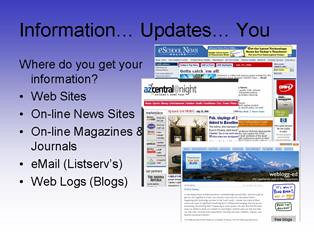
In my slide deck, I showed the audience a slide asking the question. Where do you get your information? This question was followed by five bullet points:
Of course some dialog accompanied this slide.
Slide 2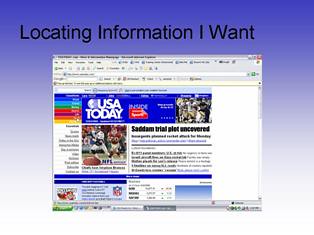
The next side contained a screen capture video as I sent to three different web sites looking for new information. The video had been edited down to 18 second and I noted to the audience that I had removed all the wait time as the pages loaded. The purpose of this slide was to remind them how much time they spend hunting for new information rather and reading it.
Slide 3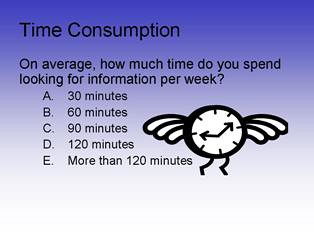
This slide pointed asked the question to the audience… How much time do you spend looking for information? I also asked a few people to share how much time they spent looking.
Slide 4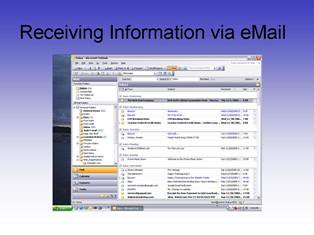
This slide moved into some of the issue with receiving information through email. Embedded in the slide is a screen capture of my personal inbox. On this day 131 messages came to my inbox. Only three were messages that I had wanted to receive. One from a friend and the other two were for list I belong to.
Slide 5
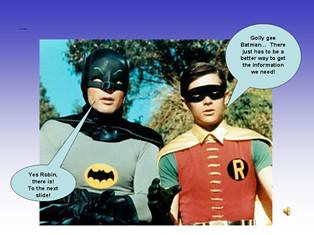
Strictly Comic Relief… And my transition to the actual concept of RSS
Slide 6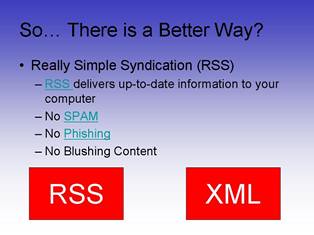
In this slide I explained that using a piece of software, a person could
subscribe to a web site. That software would track the web site for any new
information. When the web site was updated, the software would let the person know about the update. All of this was possible thanks to a concept called a RSS feed.
Once the person knew about the update, he/she could read the headline and the description and choose to read more or go to the next item.
I also point out there is no spam, phishing or blushing content that many of use receive in our email.
Slide 7
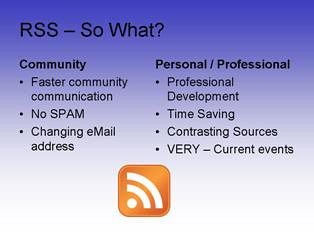
In this slide, I explained how RSS could be used in education. I complied some of the following information from a blog ran by
Amy Gahran Check out What Are Webfeeds (RSS), and Why Should You Care?
Faster communication with community
RSS is text only there for it give the reader a quick overview to choose if they want to wait for the page to load.
No SPAM
Opt in listservs and email alert are nice but they are not SPAM proof. eMail address changes It is becoming increasingly difficult to keep email list up to date due to user continually changing their email to avoid spam.
Professional Development
By subscribing to various news sources, web sites and blogs, you are able to stay abreast of current information you want to know about.
Time Saving
We have touched on this once before, however, it does top the charts in why RSS
will make a difference bringing information to you.
Contrasting Sources
Consider subscribing to two different sources for content to compare and contrast. Example: Guardian Unlimited and AzCentral.com.
VERY – Current events
Aggregators may be set to check for updates at regular intervals. The means
information is made available even when you are not looking for it.
Slide 8 & 9
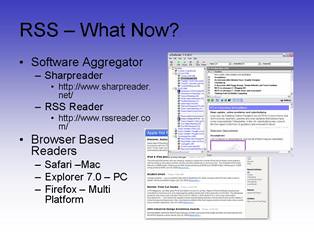
Time for “THE WORD” to emerge. The introduction of the Aggregator. In these slides I explained three type of aggregators:
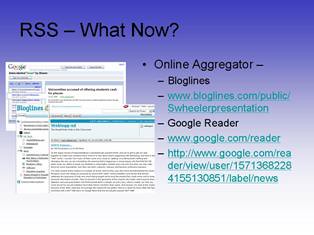
Slide 10
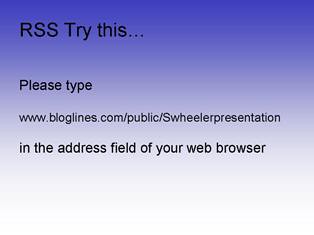
We took a tour of
my example Bloglines online aggregator. Fortunately we were in a computer lab so I had each participant register for their own Bloglines account and they subscribed to a few example educational RSS feeds I had supplied to them.
As I stated earlier. I not sold this is the best way to explain RSS. If you have a spin or an improvement to what I did here, I would love the feedback.
Today, (Saturday August 12th) after reading his follow on post (See What is RSS cont. ) I thought I would share the process I used the last time I attempted to explain RSS to a group of educators. Please keep in mind; I don’t feel this is the best way to accomplish the task. I am still searching for a better method.
The Setting…
A leadership workshop sponsored by Arizona Department of Education. Topics in my workshop included RSS, Podcasting, Blogging and Social Bookmarks. (Too much for 90 minutes by the way.
How RSS was explained….

In my slide deck, I showed the audience a slide asking the question. Where do you get your information? This question was followed by five bullet points:
- Web Sites
- On-line News Sites
- On-line Magazines & Journals
- eMail (Listserv’s)
- Web Logs (Blogs)
Of course some dialog accompanied this slide.
Slide 2

The next side contained a screen capture video as I sent to three different web sites looking for new information. The video had been edited down to 18 second and I noted to the audience that I had removed all the wait time as the pages loaded. The purpose of this slide was to remind them how much time they spend hunting for new information rather and reading it.
Slide 3

This slide pointed asked the question to the audience… How much time do you spend looking for information? I also asked a few people to share how much time they spent looking.
Slide 4

This slide moved into some of the issue with receiving information through email. Embedded in the slide is a screen capture of my personal inbox. On this day 131 messages came to my inbox. Only three were messages that I had wanted to receive. One from a friend and the other two were for list I belong to.
Slide 5

Strictly Comic Relief… And my transition to the actual concept of RSS
Slide 6

In this slide I explained that using a piece of software, a person could
subscribe to a web site. That software would track the web site for any new
information. When the web site was updated, the software would let the person know about the update. All of this was possible thanks to a concept called a RSS feed.
Once the person knew about the update, he/she could read the headline and the description and choose to read more or go to the next item.
I also point out there is no spam, phishing or blushing content that many of use receive in our email.
Slide 7

In this slide, I explained how RSS could be used in education. I complied some of the following information from a blog ran by
Amy Gahran Check out What Are Webfeeds (RSS), and Why Should You Care?
Faster communication with community
RSS is text only there for it give the reader a quick overview to choose if they want to wait for the page to load.
No SPAM
Opt in listservs and email alert are nice but they are not SPAM proof. eMail address changes It is becoming increasingly difficult to keep email list up to date due to user continually changing their email to avoid spam.
Professional Development
By subscribing to various news sources, web sites and blogs, you are able to stay abreast of current information you want to know about.
Time Saving
We have touched on this once before, however, it does top the charts in why RSS
will make a difference bringing information to you.
Contrasting Sources
Consider subscribing to two different sources for content to compare and contrast. Example: Guardian Unlimited and AzCentral.com.
VERY – Current events
Aggregators may be set to check for updates at regular intervals. The means
information is made available even when you are not looking for it.
Slide 8 & 9

Time for “THE WORD” to emerge. The introduction of the Aggregator. In these slides I explained three type of aggregators:
- Software
- Browser based
- Online

Slide 10

We took a tour of
my example Bloglines online aggregator. Fortunately we were in a computer lab so I had each participant register for their own Bloglines account and they subscribed to a few example educational RSS feeds I had supplied to them.
As I stated earlier. I not sold this is the best way to explain RSS. If you have a spin or an improvement to what I did here, I would love the feedback.
Subscribe to:
Posts (Atom)






 Digg/shawnwheeler
Digg/shawnwheeler Flickr/shawnwheeler
Flickr/shawnwheeler Linkedin/shawnwheeler
Linkedin/shawnwheeler YouTube/ShawnErikWheeler
YouTube/ShawnErikWheeler Del.icio.us/shawnwheeler
Del.icio.us/shawnwheeler Wikipedia/shawn_erik_wheeler
Wikipedia/shawn_erik_wheeler GMail/Shawn Wheeler
GMail/Shawn Wheeler Technorati/shawnwheeler
Technorati/shawnwheeler Blog/Shawn Wheeler
Blog/Shawn Wheeler